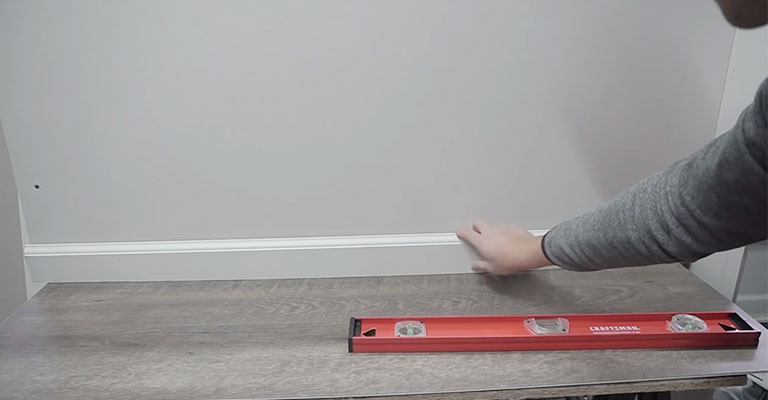How Do You Fill The Gap Between A Bathroom Vanity And A Wall?
It’s no surprise that vanity cabinets are becoming increasingly popular. There are many benefits to installing them in your bathroom, and they provide a focal point for most bathroom designs.
There may be a gap between your vanity and the wall when you’re installing one in your bathroom. In the case of antique vanities with long edges on the top, this space can be caused by extended legs. A few different methods can fill the space.
Want your vanity and wall to fit together seamlessly? The gap can be closed in several ways, including by using a backer rod. Here’s how you can close the gap between your vanity and wall, regardless of whether you use a backer rod or sealant tape.
First, ensure that your vanity is flush with the wall to fix a gap between it and your wall. After that, you can use silicone caulk to fill the gap. A backer rod or backsplash can also be added to close the gap. Finally, the sidewall can be tiled or painted.
Ultimately, the best method will depend on how much space needs to be filled and your decorative preferences. A vanity top can be filled in several different ways. Here are some of the most common ways.
Filling The Gap Between A Bathroom Vanity And A Wall
It can be important to know your options when it comes to installing a bathroom vanity, particularly if you are concerned about the famous gap issue. Here are the details.
Filling a gap can be accomplished by deciding how large the gap is, the vanity color, and the wall color. You should take this into consideration, especially if you plan to add trim molding. Here are some options to consider.
1. Trim The Gap

A piece of trim can also be installed over the gap if you have a larger gap or wish to add more decorative touches. If you choose this option, you can choose from several different trims.
There are two types of molding commonly used: rectangular molding and quarter-round molding. Trim is typically priced between $0.50 and $0.75 per foot, making this method relatively affordable.
Make sure you measure the gap’s width and length before installing the trim. Construction glue should be used instead of nails to attach the trim, as nails might damage the vanity’s top. Make sure to prime and paint the trim before painting it if you plan on painting it.
2. Make Sure Your Backsplash Is Thicker
Utilizing a backsplash is one of the easiest ways to remove gaps between a vanity and a back wall. In addition to making gaps seem almost nonexistent, thicker backsplashes also give your cabinets the appearance of being flush with the wall.
You can keep your bathroom look perfect by using a backsplash if you are concerned about sealant tape and similar techniques. Furthermore, thick-set backsplashes have the advantage of covering large gaps better than most other solutions.
3. Use Caulk And A Backer Rod

In addition, placing a backer rod in the cabinet’s gap is another easy way to get rid of medium-sized gaps. Caulk can be used to seal the rod and help it blend in with nearby surroundings after the backer rod is installed.
It would be best if you used color-matching caulk to seal the gap between a vanity and a wall. You will therefore be less likely to have a visually distracting border around your vanity. The next best choice is to use clear-drying caulk if you cannot find a caulk that matches the cabinetry.
4. Caulk The Gap

Latex or silicone caulk can be used to fill narrow gaps, such as those less than half an inch thick. Backer rods are recommended if the gap is wider. Caulk will not form holes when you use this thin foam tube to support it.
Install the backer rod inside the gap before caulking it with caulk if you are going to install one. Depending on whether the vanity is attached to the wall, you may have to unscrew it.
Use painter’s tape to protect the top edge of the vanity and the wall while applying the caulk. This will keep the caulk from spilling onto those surfaces. Ensure that you note the color of the caulk that you intend to use. Choose either a caulk that matches the countertop or one that is colorless.
To prevent voids in the caulk line, make sure to spread the caulk in a thin bead as evenly as possible. Then, the caulk can be applied over the rod and inside the gap with a caulk gun or a putty knife. Last but not least, do not apply paint or primer until the caulk has dried.
5. Use A Bathroom Sealant Tape

In order to eliminate small gaps between a cabinet and the back wall, the easiest way to fix them is by using bathroom sealant tape. It’s easy to use. Apply the tape to clean surfaces to keep moisture out and smooth the lining of your vanity.
What Causes Gaps Between Vanities And Walls?
If there is something in the design of the vanity that pushes the main cabinet away from the wall, then there will be a gap. In some cases, you will need space between the vanity and the wall in order to install a particular sink installation procedure.
In addition to measurements, gapping is heavily influenced by them. Gapping can also occur due to a measurement error or because you can’t find a cabinet that works with your bathroom measurements.
Is There A Gap In Every Vanity?
Based on how the vanity is built and how it is installed, there may or may not be a gap between the walls. However, there will be gaps in most vanities.
A careful planning process can prevent gaps from occurring in all vanities. Cabinets with gaps are difficult to install, so choosing one that isn’t prone to them is important.
Is It Necessary For A Vanity To Be Flush With The Wall?
In fact, yes. It is most common for vanity cabinets to lie flush against walls. However, it does not need to be positioned directly against a freestanding or specialty vanity if it is customized.
Is It Okay To Leave A 2-Inch Gap Between My Vanity And Wall?
The vanity should not have a gap of more than two inches between it and the wall. Installing a vanity requires flush installation (so that nothing falls into the gap). When installing a freestanding vanity, leave a four-inch gap between the edge of the vanity and the wall.
What Is The Recommended Distance Between The Vanity Sink And The Wall?
The plumbing code requires a minimum clearance of 15 inches between the vanity sink and any adjacent walls. Experts recommend 20-30 inches of clearance at a minimum, but these specifications are the bare minimum. In any case, you are free to install the vanity flush with the wall if you wish.
Final Words
No matter how close your vanity is to the bathroom wall, the smallest gap can make a noticeable difference. And sometimes, the gap will occur after the vanity has already been installed due to loose wall studs or foundational shifts.
It’s common for vanities and walls to have gaps, but that doesn’t mean you should avoid getting the vanity you want. Depending on the size of the gap and the position of your vanity in your bathroom, there are various ways to fill in those gaps.
A gap-free bathroom vanity creates the smooth, clean, and effortlessly chic look you’re looking for. There are some methods that may require additional building or expensive materials, but they are always possible. An effort and a bit of creativity are all it takes.





